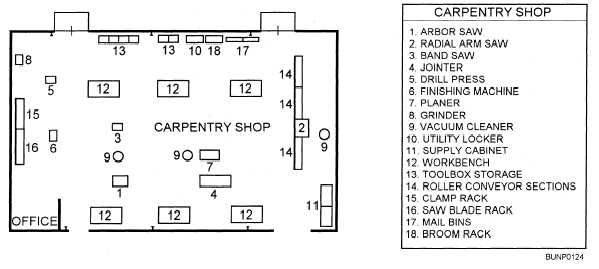dominant in that shop. The layout in figure 5-1 maybe used as a guide in laying out a carpentry shop.
In planning the arrangement of equipment, consider such factors as sequence of operations, working space, clear shop entrance and exit, adequate workbenches, and safety. The positioning of equipment, layout tables, and so on, do NOT have to be the same in one shop as in another.
Try to place stationary machines so that the work will flow in an orderly and logical sequence. It is probably easier to do this in a specialized shop than it is in a general-purpose shop where the work differs considerably from one day to another.
In shops where there is a series of operations to be performed, the relative position of the various pieces of equipment has an important bearing on efficient operations. Not only should the equipment be accessible, but it should also be arranged to save wasted motion and to reduce walking distance.
This will enable your personnel to turn out more work when their equipment is close at hand. Clearance between adjacent machines should be such that the operators will NOT get in the way of one another. Electrical outlets should be readily available to the workbenches. Needless delays are caused by having to rig extension cords from poorly located outlets.
Your plans should include adequate means for storing tools and materials. When considerable amounts of materials must be kept on hand and space permits, a special storeroom maybe used for storage of materials. Where desirable, a portion of this storeroom may also be used for storage of tools and equipment. When a storeroom is available, however, it may still be advantageous to store certain material in the shop near the machines or equipment on which it is used. Refer to the Occupational Safety and Health Standards for the Construction Industry, Code of Federal Regulations (29 CFR PART 1910) for more information on storage of tools, material, and equipment.
The amounts and types of materials stored in your shop will depend largely upon the space available and the intended purpose of your shop. In most shops, you will probably need facilities for storing such items as bolts, nuts, nails, screws, and paint. Whatever the type of shop, you should make an effort to see that your storage facilities are arranged to give the greatest possible amount of free working space.
FLOOR
In today's industry, concrete is the most widely used flooring material and possibly the most unsatisfactory flooring material for shops. Even when painted or sealed to eliminate dust, the concrete floor is

Figure 5-1. - Typical layout of a carpentry shop.
Continue Reading